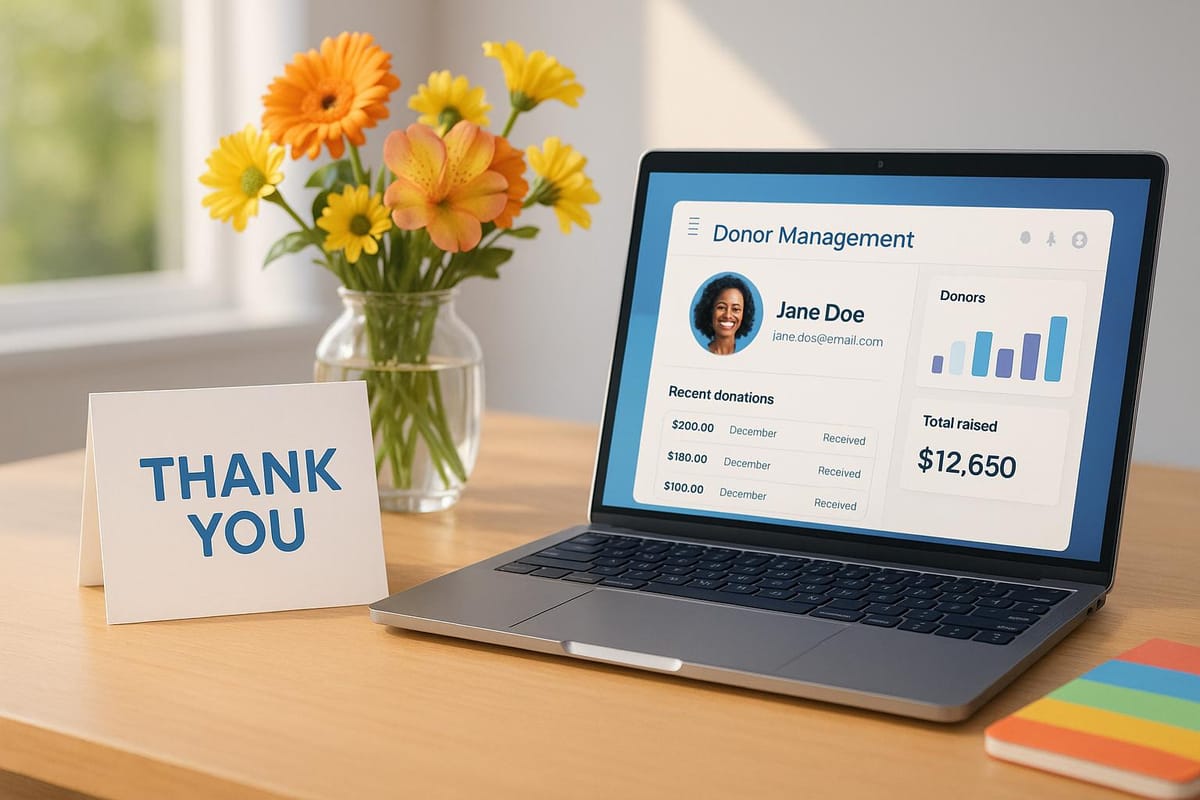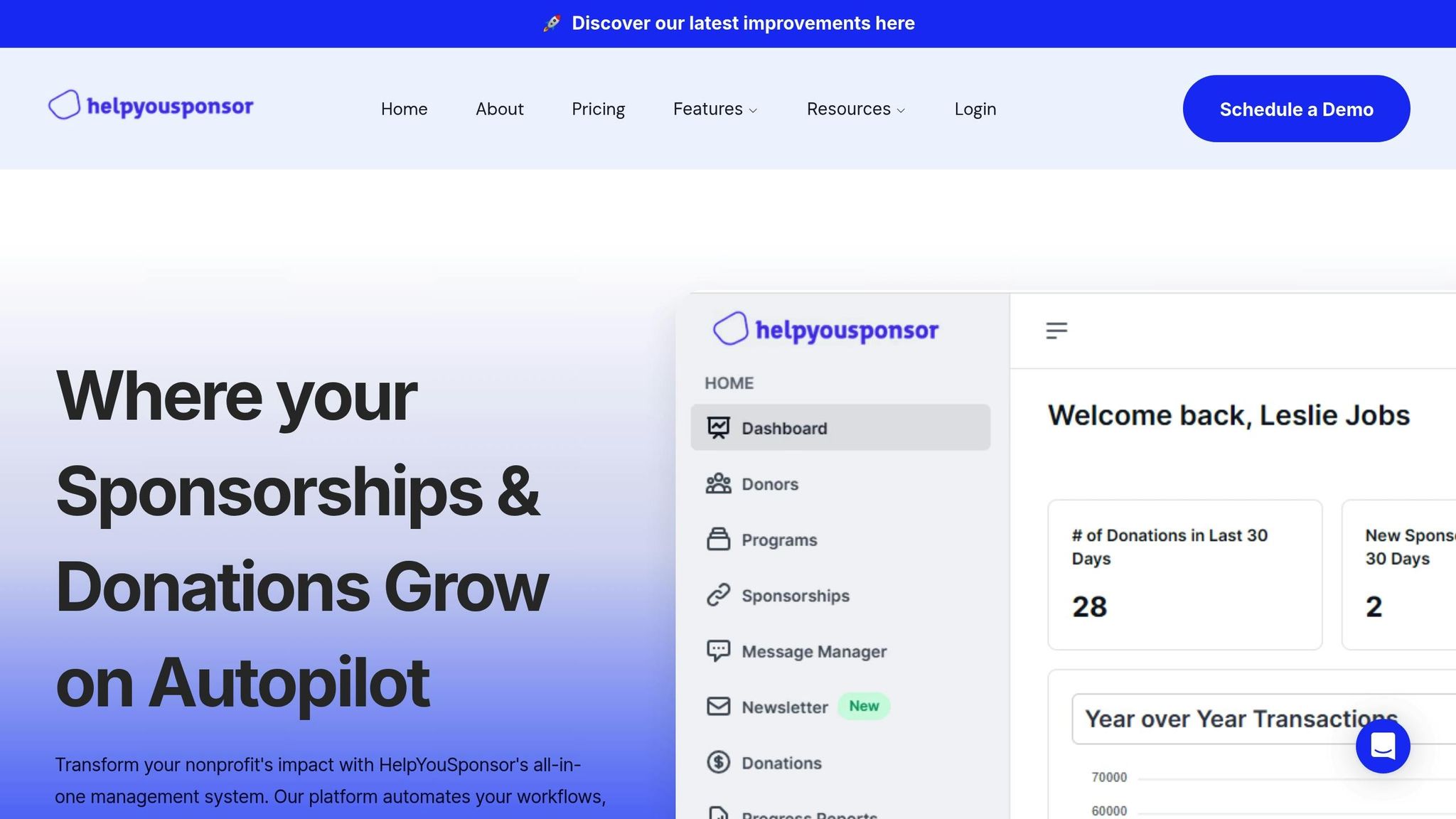Ultimate Guide to Personalized Donor Communication
Strengthen donor relationships through personalized communication strategies that engage, retain, and value supporters effectively.

Donors want more than generic messages - they want to feel recognized and valued. Personalized communication strengthens relationships, boosts engagement, and increases donor retention. Here's how nonprofits can achieve this:
- Segment donors: Group supporters by giving history, demographics, engagement, and interests to tailor communication.
- Use data effectively: Leverage donor management tools and predictive analytics to refine strategies.
- Craft personal messages: Address donors' motivations, show specific donation impact, and use storytelling to build emotional connections.
- Choose the right channels: Match communication methods to donor preferences (email, phone, text, or direct mail).
- Embrace technology: Automate personalization with tools like HelpYouSponsor to manage data and streamline outreach.
Donor Communications Made Simple
Understanding Donor Segmentation
Donor segmentation is all about grouping your supporters based on shared traits. Instead of addressing everyone the same way, segmentation allows you to understand what drives different types of donors. This makes it possible to craft personalized messages that speak directly to their interests and motivations. Let’s dive into the key factors that shape effective donor segmentation.
Breaking your donor database into meaningful groups helps you communicate more effectively. For instance, monthly donors might need different updates than those who give large, one-time gifts. Similarly, younger donors may prefer digital channels like social media, while older supporters might respond better to direct mail. By understanding these differences, you can create messages that truly resonate.
Key Segmentation Criteria
Giving history is a great starting point. First-time donors often appreciate welcome messages and basic introductions to your mission, while long-term supporters value updates on the impact of their contributions. Donation size also matters - major donors might expect detailed reports and exclusive updates, whereas smaller donors may prefer concise stories that highlight the difference their gifts make.
Demographics play a critical role in tailoring your communication. Age, for example, impacts how donors prefer to connect: those under 40 often favor social media and text messages, while those over 60 tend to engage more through email or direct mail. Location is another factor, especially for organizations with regional programs or events.
Engagement patterns reveal how involved donors are beyond just giving. Some might attend events regularly, while others volunteer or engage primarily online. Highly active donors may welcome frequent updates, while less engaged supporters might prefer occasional check-ins.
Communication preferences are essential for ensuring your messages are well-received. While some donors eagerly open every email, others might prefer phone calls or text updates for important news.
Interest areas allow you to connect donors with the causes they care about most. For example, an environmental nonprofit could segment supporters based on their passions - whether it’s wildlife conservation, renewable energy, or climate advocacy - enabling more targeted and relevant communication.
Using Data to Improve Segmentation
Data is the backbone of effective donor segmentation. It not only helps identify different groups but also guides how to engage with them.
Modern donor management platforms simplify this process by consolidating key information - like demographics, giving history, engagement levels, and interests - into one centralized system. These tools save time by automating pattern analysis, allowing staff to focus on relationship-building rather than manual data sorting.
Predictive analytics takes it a step further, using past data to forecast future donor behavior. These insights can pinpoint donors likely to increase their giving, those at risk of disengaging, or supporters most likely to respond to specific campaigns. This helps organizations proactively adjust their strategies instead of reacting after the fact.
Real-time insights make it easier to adapt as donor behavior changes. Instead of waiting for annual reviews, nonprofits can identify trends and refine their segmentation strategies immediately, ensuring their approach stays relevant.
Automation also plays a key role, handling much of the data analysis so staff can focus on crafting compelling messages and strengthening donor connections. Many large nonprofits have successfully used predictive analytics to improve retention rates and boost fundraising through targeted strategies.
"Predictive analytics is a powerful tool that is transforming the nonprofit sector by enabling organizations to make data-driven decisions, optimize their fundraising strategies, and cultivate stronger relationships with their donors." – Sarah Lee, AI generated Llama-4-Maverick-17B-128E-Instruct-FP8
Platforms like HelpYouSponsor address these challenges by offering comprehensive donor management tools. By tracking interactions across multiple touchpoints - from initial contact to long-term engagement - they help create accurate, actionable donor segments.
To make the most of data-driven segmentation, nonprofits must prioritize data quality. Regularly updating and cleaning donor information ensures that analytics tools work with accurate, current data. Starting with smaller pilot projects can help test strategies before rolling them out organization-wide, while ongoing monitoring allows for continuous improvement based on real-world results. These efforts directly support donor retention by ensuring every communication feels meaningful and relevant.
Creating Personalized and Effective Donor Messages
After segmenting your audience effectively, the next step is to craft messages that feel personal and meaningful. When donors receive communications that reflect their unique relationship with your organization, they’re more likely to stay engaged and continue supporting your cause.
Techniques for Personalization
Go beyond using their name - connect to their reason for giving. If you understand why a donor contributes, you can tailor your message to resonate with their motivations. For instance, if someone supports your environmental group because of their passion for conservation, referencing their dedication can create a stronger emotional connection and align with their giving journey.
Be specific about the impact of their donation. Instead of vague gratitude like "Your gift was helpful", share concrete examples: "Your generous gift kept 126 kittens safe during the recent blizzard". This level of detail helps donors visualize the difference they’ve made.
Use a conversational tone. Write as though you’re talking to a friend. For example, Mark Mehling, a nonprofit copywriter, advises using a personal approach: "Hello Mary, this is Frank from Costs for Kittens to tell you how you have changed …". A warm, direct tone makes your message feel genuine and heartfelt.
Highlight long-term impact. Send follow-up messages that remind donors of the lasting effects of their contributions, particularly during critical moments or major events.
A real-world example shows how personalization works. In June 2024, an environmental nonprofit sent Sophie - a donor in her thirties - a tailored email with the subject line: "Sophie, make your environmental legacy live on!" The email acknowledged her commitment, detailed the specific outcomes of her support, and invited her to a beach cleanup event. This personalized approach inspired Sophie to get involved, while a generic email might not have sparked the same level of engagement.
Using these personalization techniques can transform donor outreach, but pairing them with compelling stories takes engagement to the next level.
The Power of Storytelling
Stories can create emotional connections that raw data or statistics simply can’t. Sharing specific examples of how a donor’s contributions have made a difference allows them to see the tangible impact of their support.
Focus on individual stories. While overall impact numbers are useful, personal accounts - like how a single family benefited from a donation or how a project came to life because of their generosity - are far more powerful. These stories help donors feel emotionally invested.
Make the donor the hero. Frame the narrative so that their support takes center stage. Instead of making your organization the sole hero, highlight how their generosity created positive change. This approach builds a sense of pride and ownership in the shared success.
Keep it authentic. Avoid sounding overly flowery or insincere, especially when acknowledging smaller donation. Authenticity builds trust and ensures your message feels genuine.
Align stories with donor interests. Share stories that reflect what matters most to each donor. For someone passionate about education, highlight how their donation helped students thrive. If they care deeply about animal welfare, share stories of rescued animals who benefited from their generosity. By connecting the story to their values, you create a message that feels personal and relevant.
Modern donor management tools can simplify personalization. Platforms like HelpYouSponsor offer features to organize donor data and track engagement, making it easier to create targeted and impactful communications tailored to each individual.
Choosing the Right Communication Channels
Once you've crafted personalized messages, the next step is deciding how to deliver them. The right communication channel can make or break your connection with donors, as preferences often vary across different groups. Understanding these nuances is key to boosting engagement and achieving fundraising goals.
Think about donor demographics. For example, older donors might favor direct mail or phone calls, while younger ones are more likely to respond to email, text messages, or social media. Preferences aren't one-size-fits-all, so tailoring your approach is essential.
Match the channel to the message. Urgent appeals are best suited for quick digital methods like text or email, while detailed updates may resonate better through formats like newsletters or letters.
Consider the relationship stage. A new donor might appreciate a warm welcome via a phone call or a handwritten note. Long-term supporters, on the other hand, value consistent communication through their preferred channels, but without feeling inundated.
With these points in mind, let’s explore how each communication channel can be used effectively.
Channel Comparison and Best Practices
Every communication channel brings unique advantages and challenges. For instance:
- Email is popular for its scalability and ability to be personalized at scale.
- Phone calls add a personal touch that can strengthen relationships.
- Text messages are perfect for immediate, time-sensitive outreach.
- Direct mail offers a tangible, memorable experience that some donors still find meaningful.
Experimentation is key. Test different subject lines, timing, and formats to see what resonates most with your audience. As you gather insights, refine your approach to enhance the effectiveness of your campaigns.
Tools like HelpYouSponsor can simplify multi-channel coordination. These platforms help ensure consistent messaging, track donor engagement, and streamline your efforts, making it easier to deliver cohesive and impactful communication across all touchpoints.
Using Technology for Scalable Personalization
Donor segmentation and personalized messaging are essential for building strong connections, but managing these efforts across hundreds or thousands of donors can feel like an uphill battle. Thankfully, technology now makes it easier to deliver tailored experiences on a large scale - without requiring a huge team or a hefty budget.
The magic lies in automation that retains a personal touch. Modern donor management platforms take care of tasks like segmentation, message customization, and delivery timing, all while keeping communications meaningful and human. This frees up your team to focus on strategy and relationship-building instead of spending countless hours on manual tasks.
Data integration is the backbone of effective personalization. When donor details, communication history, and engagement metrics are all stored in one centralized system, you can set up rules that personalize outreach automatically. For example, you can create automated welcome emails for new donors, send birthday greetings to loyal supporters, or craft appeals that align with an individual’s giving history.
The best platforms also offer real-time insights, allowing you to quickly tweak your messaging or outreach channels if you notice a drop in engagement with certain donor groups.
Key Features of HelpYouSponsor

HelpYouSponsor is designed to make scalable personalization effortless, combining all the tools you need into one streamlined donor management system. Here’s how it works:
- All-in-One Donor Management: Track donations, consolidate donor data, and automate key tasks like receipts and thank-you messages - all from a single platform.
- Automated Messaging: Stay connected with donors through personalized thank-you notes, donation reminders, and project updates. These messages are triggered by donor behavior and preferences, ensuring no one is overlooked while maintaining a warm, personal tone.
- Detailed Donation Tracking: Get access to reports that reveal giving patterns, preferred communication methods, and engagement levels across different donor groups. This data helps you fine-tune your campaigns and outreach strategies.
- Donor Self-Service Portals: Supporters can manage their preferences, review their giving history, and stay engaged with your mission through a personalized online account. This not only reduces administrative work for your team but also empowers donors to take control of their experience.
- Website Integration: Display sponsorship opportunities and donation appeals directly on your site, creating a seamless journey from interest to contribution. With payment gateway integration, the donation process is smooth and hassle-free.
HelpYouSponsor’s pricing is designed to fit organizations of all sizes. The Free Plan supports up to 10 commitments per month. The Pro Plan, at $50/month, accommodates up to 63 commitments. For larger needs, the Max Plan offers usage-based pricing at $0.80 per commitment. This flexible structure ensures you only pay for what you use, making advanced donor management tools accessible to everyone.
Measuring Success and Improving Over Time
Personalized donor communication isn’t something you can just set up once and forget. The most effective nonprofits treat it as an ongoing process, constantly evaluating and fine-tuning their approach. Without tracking and adjusting, you risk missing opportunities to strengthen donor relationships.
To succeed, you need a structured system to measure performance and refine your strategies. This means going beyond simple metrics like total donations and digging deeper into how personalization impacts donor behavior.
Metrics to Track
Engagement metrics are a great starting point to gauge how well your personalized messages connect with donors. Email open rates can tell you if your subject lines and sender reputation are catching attention. Click-through rates go further, showing whether your content inspires action.
Response rates can reveal which appeals work best. For example, appeals targeting major donors often provide valuable insights for shaping future campaigns.
Donor retention rates are another key measure of success. Monitor how many donors give again within 12 months of their first contribution, and compare retention rates between those who receive personalized communications and those who don’t. The difference often highlights the value of personalization.
Contribution patterns offer a financial perspective on your efforts. Track metrics like average gift size, donation frequency, and upgrade rates (the percentage of donors who increase their giving over time). Donors who feel a personal connection to your cause are more likely to give more generously and more often.
Channel effectiveness helps you identify where to focus your outreach. Some donors respond best to email, while others prefer phone calls or direct mail. By tracking response rates across different channels for each donor segment, you can fine-tune your communication strategy.
Don’t overlook direct feedback from donors. Post-donation surveys asking about communication preferences or satisfaction levels can uncover gaps in your approach that metrics alone might miss. These insights can guide adjustments to make your personalization efforts even more effective.
Continuous Optimization
Once you’ve gathered data, use it to drive ongoing improvements. Look for patterns in your metrics - such as which donor segments show the highest engagement, which messages generate the strongest responses, and which communication channels yield the best results.
A/B testing should be a regular part of your strategy. Experiment with different subject lines, messaging styles, or call-to-action buttons to see what resonates most. Even small improvements in open or click-through rates can lead to significant increases in donations.
Seasonal analysis can help you time your outreach effectively. Many donors follow predictable patterns, such as giving at year-end for tax benefits or during specific awareness months. Use historical data to spot these trends and adjust your communication calendar accordingly.
Platforms like HelpYouSponsor make this process easier by providing real-time analytics. These tools show how different donor segments respond to various communication strategies, helping you identify trends and opportunities quickly. You can track which automated messages perform best, spot donors ready for an upgrade appeal, and see which communication methods drive the most engagement.
Real-time insights also allow you to act fast when something isn’t working. For instance, if a donor segment shows declining engagement, you can immediately tweak your messaging or try a new channel - no need to wait for a full campaign review.
Regular review cycles are essential to keeping your strategy sharp. Schedule monthly reviews to monitor key metrics and conduct deeper dives into donor segment performance every quarter. This consistent evaluation helps you catch issues early and build on successful strategies before they lose momentum.
As donor preferences shift over time, it’s important to stay flexible and open to experimenting with new approaches. Use your data as a guide, and be ready to adjust your strategy to keep your communications relevant and impactful.
Conclusion: Building Meaningful Donor Relationships
Creating strong, lasting connections with donors starts with personalized communication. When you move away from one-size-fits-all mailings and focus on treating donors as individuals - each with their own motivations and preferences - you lay the groundwork for relationships that can stand the test of time.
This approach brings together essential elements like thoughtful segmentation, tailored messaging, smart channel selection, and the use of technology. Together, these strategies help you truly understand your donors, engage with them in ways they appreciate, and scale those personal touches effectively.
HelpYouSponsor simplifies this process by combining donor management, communication tracking, and analytics into one cohesive platform. With everything in one place, your team can focus on building genuine connections. The platform's real-time insights allow you to act quickly - whether that’s reaching out to a donor who's ready to make a major gift or addressing signs of waning engagement before it affects retention.
Every personalized interaction strengthens donor loyalty. By taking the time to understand what matters to your donors and communicating accordingly, you show that their partnership is valued. This level of respect fosters trust, and trust is the foundation of relationships that sustain nonprofits through both challenges and successes.
Nonprofits that make donor relationships a priority are the ones that thrive. By applying the strategies in this guide and using tools that support personalized communication on a larger scale, you're setting your organization up for long-term success - building connections that benefit both your donors and the communities you serve.
FAQs
How can nonprofits use predictive analytics to boost donor retention?
Nonprofits can use predictive analytics to boost donor retention by examining past donor data to spot patterns and predict future giving habits. This helps organizations craft personalized and timely communication strategies that better connect with their supporters.
By identifying donors who are likely to stay engaged or those at risk of stopping their contributions, nonprofits can concentrate on building stronger relationships with key supporters. They can also design tailored engagement campaigns and direct resources to areas that matter most. This focused strategy not only deepens donor loyalty but also makes fundraising efforts more efficient.
How can nonprofits choose the best communication channels for different donor groups?
Choosing the Right Communication Channels for Donors
Nonprofits can better connect with their donors by segmenting them into groups based on factors like age, location, income, and personal preferences. For instance, younger donors are often more active on social media or respond well to text messages, while older donors might lean toward email or traditional direct mail.
By understanding what works best for each group, nonprofits can craft messages that truly resonate. Matching communication methods to donor preferences not only helps strengthen connections but also encourages ongoing engagement and support.
How does HelpYouSponsor make donor communication more personalized and scalable?
HelpYouSponsor makes connecting with donors on a personal level easier than ever. It offers tools like audience segmentation, dynamic content, and behavior-based triggers to craft messages that truly resonate with each donor.
On top of that, its automated donor journeys ensure communications are both timely and meaningful. This not only helps nonprofits strengthen their relationships with supporters but also saves valuable time and resources in the process.

